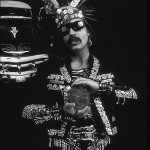Guillermo Gómez-Peña was born in 1955 and raised in Mexico City. He came to the United States in 1978. In his work, which includes performance art, video, audio, installations, poetry, journalism, critical writings and cultural theory, he explores cross-cultural issues and North/South relations. His performances have been presented nationally at the Franklin Furnace and Next Exit, New York, and MOCA, Los Angeles; and internationally at La Fundación Juan Miró, Barcelona, and The Royal National Theatre, London. He is the recipient of an American Book Award for his book, New World Border, the Prix de la Parole, New York’s Bessie Award and a MacArthur Foundation Fellowship, among many other honors.

STATEMENT
The late ’60s in Mexico were a time of artistic diaspora. Many experimental artists who felt suffocated by the inflexible monodisciplinary structures of the official culture left the country in search of aesthetic and political freedom, and spread out through Europe and the United States. A decade later, my permanently unsatisfied friends and I departed, following the footprints of our older compadres.
In 1992 Felicia Rice, director of Moving Parts Press, invited Enrique Chagoya and me to collaborate in an extremely ambitious book art piece. El Che-goya and I were ecstatic. We had been waiting for years for the opportunity to collaborate on a long-term project, and to compare notes so to speak. Why? Enrique and I are members of the same Mexican lost generation, and our lives have been strangely intertwined.
We both studied at the UNAM (he studied Economics, whereas I studied Linguistics). We both left Mexico City around the same time in search of the Other Mexico, first to the countryside and then to the border region. He ended up in El Paso, while I got caught by the spider web of Tijuana. When we finally crossed the borer, something broke inside of us, forever. As part of our rite of passage into El Norté, we both married Anglo-American womenan archetypal immigrant experienceand our first marriages were torn apart by cultural difference. We both ended up in California, again around the same time. We chose California because we wanted to embrace the urban Chicano experience, which at the time was completely mythical to Mexicans. I formed the Border Arts Workshop in San Diego, while he directed the legendary Galería de la Raza in San Francisco.
As a result of these and other biographical parallelisms, our sensibilities have turned out to be quite similar. We draw from pop culture (Mexican cinema, comic books, Mexican wrestling and rock en español) and politics. We both utilize our art to research and reveal the multiple processes of acculturation and hybridization that the Mexican psyche undergoes when crossing the border. We both still believe in the transformative power of art, and most important, we both have a thorny sense of humor with the following dictum: Respect nothing or no one, not even yourself.
Felicia’s challenge to us was immense: to produce a “post-Colombian” codex in response to the great Mexican crisis in California. In dialogue with Enrique and Felicia, I was to dive into my memory bank in search of poetic/conceptual and performance texts dealing with Nafta, globalization and its side effects in the territories of immigration, language, pop culture and identity politics. And Enrique was to embark on a parallel project and illustrate our shared vision. Since our times are changing so fast, and so is my literature, most of the texts I chose were later on re-written and incorporated into larger texts which appeared in my second book, New World Border (San Francisco: City Lights Books, 1996). Once we delivered the material to Felicia, we provided her with some design and structural suggestions, but it was really her incredible talent as a bookmaker that made our work coalesce into a strangely coherent visual/conceptual tapestry.
Hopefully this unique post-Columbian Spanglish CODEX is a minute contribution
to the creation of a new Chicano/Mexicano aesthetic.
Guillermo Gómez-Peña
Califas
CODEX ESPANGLIENSIS
texts are excerpted from the following performance pieces:
“A Brief History” 1993–94
Excerpts from “The Free Trade Art Agreement” 1993–94
Excerpt from “El Existentialist Mojado” 1993
”End of the Century Cultural Topography” 1995
Excerpt from “Chicanost: Radio Nuevo Orden” 1991
Excerpt from “Cabaret Babylon Aztlán” 1986
Excerpt from “Free Trade Art” 1995
Excerpt from “Auctioning the New World” 1991
“Inventario de mis primeros 4 meses de viaje” 1979
“Border Letter” 1981
Excerpt from “Califas” 1987
“Threatened, Endangered or Extinct?” 1991
Return to CODEX ESPANGLIENSIS from Columbus to the Border Patrol